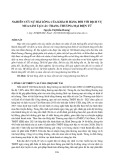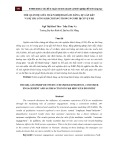
* Corresponding author
E-mail address: nhatvuonga1@gmail.com (B. N. Vuong)
© 2020 by the authors; licensee Growing Science.
doi: 10.5267/j.uscm.2019.11.004
Uncertain Supply Chain Management 8 (2020) 351–370
Contents lists available at GrowingScience
Uncertain Supply Chain Management
home
p
a
g
e: www.Growin
g
Science.com/usc
m
The influence of website quality on consumer’s e-loyalty through the mediating role of e-trust
and e-satisfaction: An evidence from online shopping in Vietnam
Ha Nam Khanh Giaoa, Bui Nhat Vuonga* and Tran Nhu Quana
aFaculty of Air Transport, Vietnam Aviation Academy, Ho Chi Minh City, Vietnam
C H R O N I C L E A B S T R A C T
Article history:
Received October 20, 2019
Received in revised format
November 10, 2019
Accepted November 20 2019
Available online
November 20 2016
The aim of the present study is to examine the influence of website quality on consumer’s e-
loyalty, noting the mediating role of e-trust, e-satisfaction, and perceived enjoyment. Besides,
this study examines the consequence of consumer’s e-loyalty. Survey data collected from 594
respondents aged at least 16 years and performed some online shopping through websites in
Vietnam. Based on the theoretical framework, PLS-SEM using SmartPLS 3.0 software was
deployed to discover links between the constructs. The results showed a positive effect of
website quality on e-loyalty, which was mediated partially through consumer e-trust and e-
satisfaction. Moreover, e-loyalty had a positive association with electronic word of mouth
(eWOM) as well. The main findings of this research provide some empirical implications for
Internet marketers and online retailers in Vietnam. E-vendors should understand the customers’
expectations and e-loyalty regarding online shopping to attract new customers as well as to
retain their existing customers.
.license Growin
g
Science, Canada2020 b
y
the authors; ©
Keywords:
Website quality
E-trust
E-satisfaction
Perceived enjoyment
E-loyalty
Electronic word of mouth
1. Introduction
Internet has been changing the traditional ways of purchasing goods and services. The users have no
longer been restricted by time and geographical factors. They could actively purchase the products and
goods regardless of any time and location factors. The Internet has brought about new methods of
communication and new ways of exchanging everyday information among peoples. The ever-
increasing number of Internet users would also coincide with the development of online purchasing
(Joines et al., 2003). The fast development of the Internet would be explained by the combination of
broadband technology and the change of customer behavior (Oppenheim, 2006). Online shopping, also
known as internet shopping or e-shopping, can be explained as electronic commerce when buyers and
sellers virtually meet others through a web browser (Kaur & Joshi, 2012). In other words, e-shopping
is a process when users decide to buy products or services on the Internet economy (Puranik & Bansal,
2014). Unlike traditional shops that require physical locations, physical security services, and specific
timeframes to operate, internet shops need none of those requirements. Customers can access to the
shop from anywhere (e.g., without worrying about geographical boundaries) and anytime (e.g., 24-hour
opening, 7 days a week, time zones) they like as long as they have internet connection and an
appropriate device like a computer, a tablet or a smartphone (Bidgoli, 2010; Karthika &






























